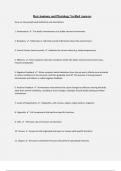Samenvatting
Summary of the literature from lecture 1-3 (2022)
This summary contains the following articles from lectures 1-3: - Bessant, John (2003): Challenges in Innovation Management. -Bloom Nicholas, Sadun, Raffaella and John Van Reenen (2012): Does Management Really Work? -Utterback, James M. and Fernando F. Suárez (1993): Patterns of Industrial ...
[Meer zien]













